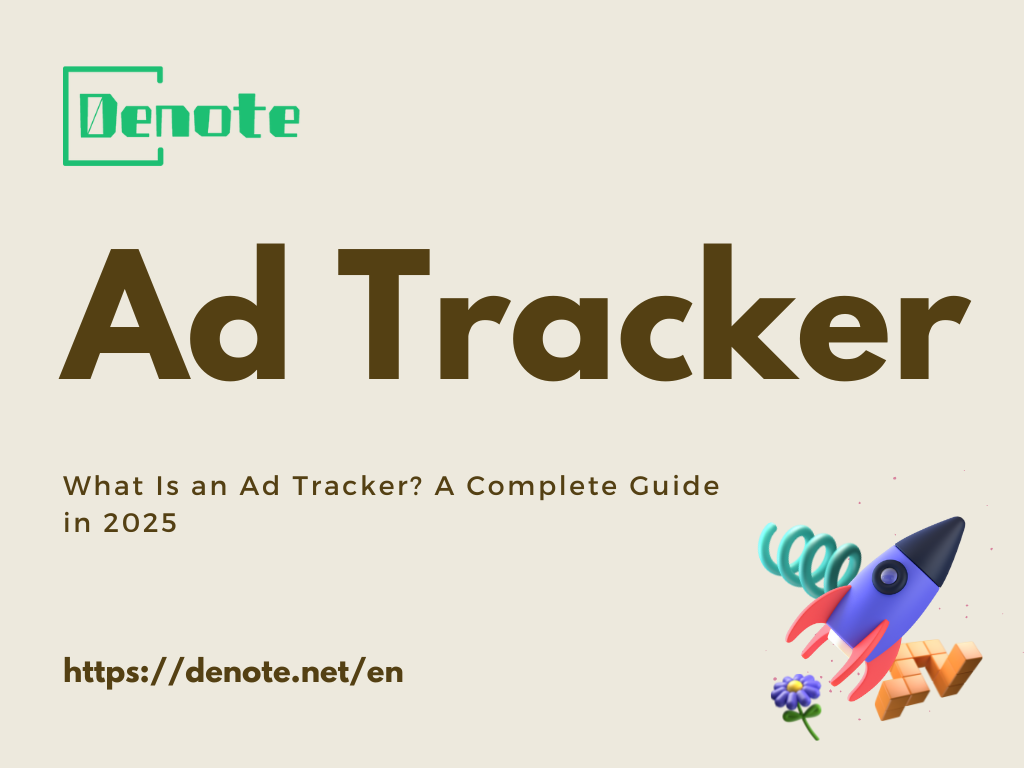What Is Growth Marketing? The Complete Guide in 2025
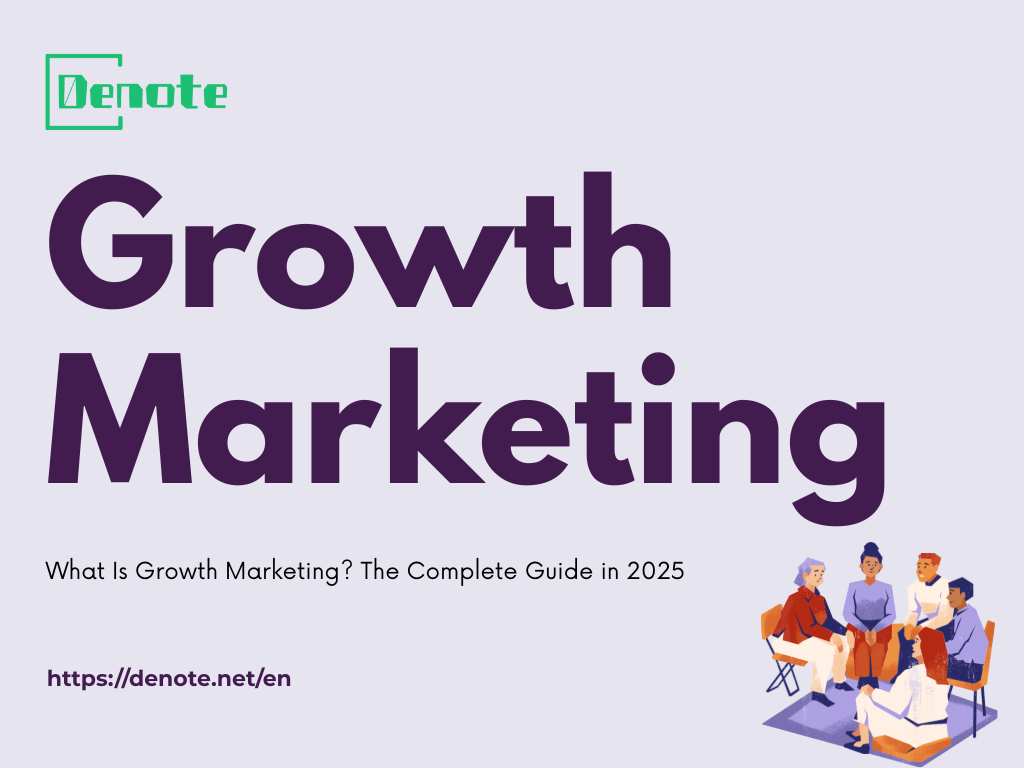
What is Growth Marketing
Imagine your business is a spaceship. Traditional marketing is like the rocket launch—it gives you that initial blast to get off the ground. But what keeps the spaceship moving through space, adjusting its course, and avoiding meteorites? That’s Growth Marketing.
Growth Marketing is not just about acquiring users—it's about creating sustainable, compound growth by experimenting, learning fast, and optimizing every stage of the customer journey. From the first touchpoint to long-term loyalty, Growth Marketing focuses on continuous improvement using data, creativity, and user psychology.
It's a mindset. A philosophy. A discipline. A little bit of science, a lot of art—and tons of iteration.

How Growth Marketing Differs from Traditional Marketing
Focus on Full Funnel
Traditional marketers often obsess over top-of-funnel metrics like impressions, reach, and traffic. But Growth Marketers? They’re full-funnel fanatics.
From awareness to advocacy, they analyze how users flow through the entire funnel:
- Awareness: How do people hear about you?
- Acquisition: What channels bring them in?
- Activation: What convinces them to take the first step (sign-up, trial, etc.)?
- Retention: Why do they stick around?
- Revenue: How are you monetizing effectively?
- Referral: Are they bringing their friends?
This full-funnel focus helps optimize the customer experience holistically, not just the entry point.
Experimentation & Rapid Testing
Growth marketing isn’t about guessing—it’s about testing. And re-testing. And running five versions of the same idea simultaneously to see what sticks.
Imagine it as a marketing test kitchen. You put forward a theory—say, “Will this onboarding email boost conversion rates?”—then roll out experiments, like A/B tests, and dig into the results. The best part? You can tweak things fast, so you’re not just sitting around waiting for answers.
A/B testing really keeps the whole process moving. Think of it as quietly collecting feedback from users, not by pestering them, but by simply tracking how they respond to different versions. It’s efficient, direct, and honestly, it’s the backbone of smart marketing strategy.
Data-Driven Decisions
In Growth Marketing, opinions don’t win. Data does. No more “gut feelings” guiding campaigns. Growth teams measure everything, and use that data to iterate and improve.
Tools like Denote make this easy by uncovering what your competitors are doing—what ads they're running, what channels they're using, and what landing pages are converting. You’re not marketing in the dark; you’re using a flashlight with heat sensors and night vision.
With proper tracking, attribution, and customer behavior analysis, Growth Marketers build predictable growth systems—not just spikes of attention.
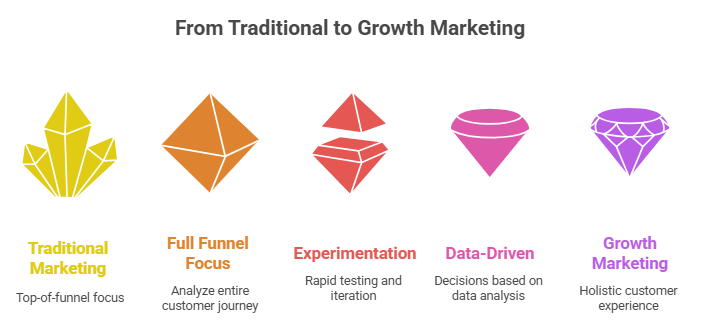
Why Growth Marketing Matters in 2025
Sustainable Growth
Let’s cut to the chase: acquiring new users has gotten ridiculously pricey, and attention spans? Basically nonexistent—think TikTok, but shorter. So, simply throwing money at the problem isn’t going to cut it anymore.
That’s where Growth Marketing steps in. It isn’t about chasing after some viral flash that fizzles out the next day. Instead, it’s a strategy focused on sustainable, long-term growth—think tending to a garden, not just buying fresh flowers to make things look good for a week.
And here’s where it gets interesting: small, consistent improvements actually drive serious results. If you increase activation by 10%, boost retention by 15%, and improve referrals by 5%, you end up with a compounding effect that delivers real, lasting growth. It’s a smarter investment—the kind that pays off over time, not just in short-lived spikes.
Lower CAC (Customer Acquisition Cost)
Customer Acquisition Cost (CAC) has a sneaky way of undermining startups if you’re not paying attention. It quietly eats into your margins before you know it. That’s why growth marketing isn’t just a buzzword—it’s essential. Instead of wasting resources on channels that aren’t delivering, you double down on what works, get your SEO and organic traffic in shape, and make sure customers stick around longer.
Even something as simple as smarter onboarding emails can seriously boost retention. Suddenly, every dollar you spend on acquiring customers stretches further. When you tighten up your funnel and fix those problem areas, your marketing budget isn’t just working—it’s actually pulling its weight.
Improved Retention Rates
Acquisition is sexy. Retention is profitable.
Growth Marketing puts strong emphasis on retention strategies, like personalized re-engagement emails, in-app nudges, loyalty programs, and customer feedback loops.
In a world where product substitutes are always a click away, retention is the new moat. And Growth Marketing builds that moat brick by data-driven brick.
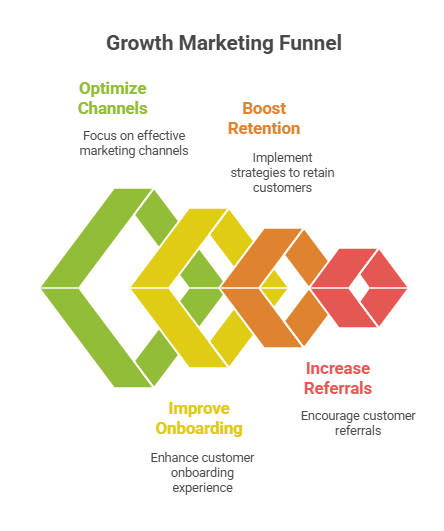
Core Components of a Growth Marketing Strategy
Data Analytics & Metrics
Growth begins with clarity—and that comes from data. You need to measure what matters, track performance, and understand user behavior.
Important metrics include:
Customer Lifetime Value (CLV)
- CAC
- Activation Rate
- Churn Rate
- Conversion Rates by Funnel Stage
Analytics tools like Google Analytics, Mixpanel, and Denote provide the dashboard you need to make smarter decisions, faster.
Funnel Optimization
You don’t need more traffic—you need to convert more of the traffic you already have.
That’s why funnel optimization is a cornerstone of Growth Marketing. It’s the art of turning interest into action.
This involves:
- Identifying drop-off points
- Running heatmaps & session recordings
- Fixing UX bottlenecks
- Improving copy & CTAs
- Streamlining onboarding
Every small tweak (like changing one word on a button) could mean thousands in extra revenue.
A/B Testing & Experimentation
Let’s say your signup page has a 10% conversion rate. What if you could push it to 15%?
With A/B testing, you run version A vs. version B to see which performs better. You test:
- Subject lines
- CTA button colors
- Hero images
- Signup form length
- Pricing models
Even failed experiments give you insights. The Growth mindset sees every test as tuition in the school of scale.
Multi-Channel Acquisition
Don’t put all your eggs in one channel—especially when those channels keep changing their algorithms.
Growth Marketing diversifies acquisition across multiple platforms, balancing paid, organic, and owned media.
SEO & Content
Content is really the long game in growth marketing. It’s not some overnight miracle, but once it starts working, you’ll see a steady stream of high-quality leads without burning through your ad budget.
Your blog, landing pages, and all those SEO-focused resources? They’re doing the heavy lifting 24/7—constantly attracting people who are actually interested in your business. It’s a smart investment that keeps paying off.
Paid Ads & Retargeting
Sometimes you need a boost. Paid ads on platforms like Google, Meta, and LinkedIn let you scale fast—especially when combined with smart retargeting.
But Growth Marketers don’t just throw money at ads. They test creatives, refine audiences, and use tools like Denote to spy on competitors and discover new ideas.

Email & Lifecycle Marketing
You’ve acquired the lead—now what?
Email flows, onboarding sequences, behavior-based triggers, and reactivation campaigns all form your lifecycle marketing machine.
Tools like HubSpot and Customer.io help deliver the right message at the right time, nudging users toward activation, conversion, and referral.
Top Growth Marketing Tools to Use
In the world of Growth Marketing, having the right tools is like having a Swiss army knife in the jungle. Sure, you could survive without them—but why would you?
Here are the most essential tools modern growth marketers rely on:
Denote
Let’s be honest: spying on your competitors is one of the smartest moves in your Growth Marketing strategy—and Denote makes it effortless.
Denote helps you:
- Discover what ads your competitors are running
- Analyze landing page variations and funnel paths
- Track messaging changes over time
- Reverse-engineer top-performing campaigns
Whether you're launching your first campaign or refining a long-term strategy, Denote empowers you to stop guessing and start optimizing based on what works in your niche.
Growth Marketers use Denote not just to imitate—but to innovate. Think of it as a cheat sheet for your marketing homework.
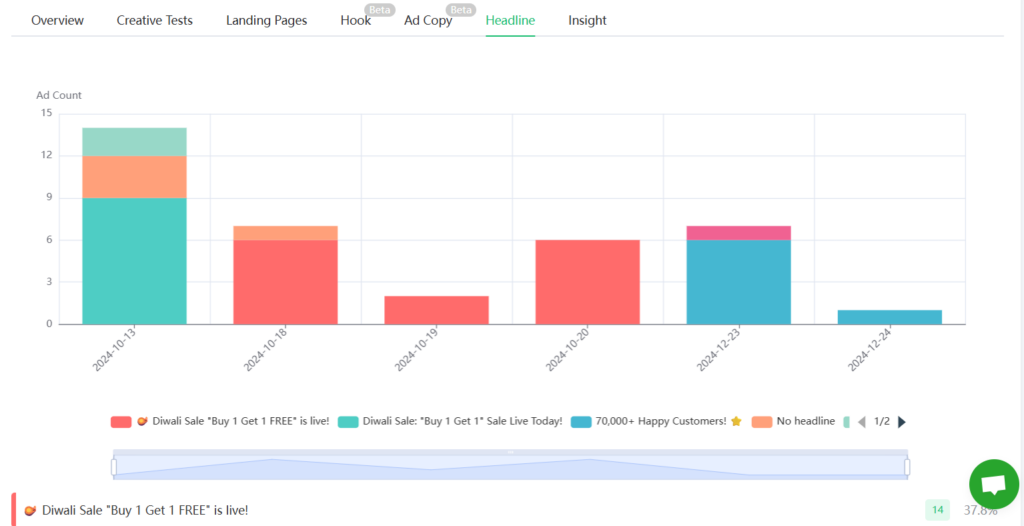
Google Analytics
An oldie but goldie.
Google Analytics is the heartbeat of any data-informed Growth Marketing system. It tells you:
- Where users come from
- What they do on your site
- Where they drop off
- How your funnel performs
- Which campaigns drive the most revenue
Growth Marketing without Google Analytics is like flying blindfolded—you’ll eventually hit something, but it won’t be pretty.
GA4, the latest version, brings deeper integration with event tracking, user journeys, and predictive modeling. If you know how to wield it, it can uncover hidden gold.
HubSpot
Think of HubSpot as your Growth Marketing command center.
It’s a full-stack platform that helps with:
- CRM & lead nurturing
- Marketing automation
- Email campaigns
- Landing pages
- A/B testing
- Attribution modeling
For teams serious about scaling, HubSpot connects your sales, marketing, and service efforts in one place—no more data silos or messy handoffs.
Even small teams can use HubSpot to automate repetitive tasks, freeing up time to focus on high-impact experiments and creative testing.
How to Build Your Own Growth Marketing Team
Growth Marketing is not a one-person job (unless you're a caffeine-fueled genius). As your ambitions grow, so should your team.
Here’s how to structure a high-performing Growth Marketing team:
Key Roles
Growth Lead
The conductor of your growth orchestra. They define strategy, prioritize experiments, and connect dots across product, data, and marketing. A good Growth Lead is part analyst, part creative, part product manager.
Product Marketer
They operate right at the crossroads of product development and the customer base. Their main responsibility? Shaping messaging, fine-tuning positioning, and ensuring every feature actually reaches its intended audience. Think of them as translators—they take technical product details and turn them into marketing campaigns that highlight real value.
Data Analyst
Without analysts, you’re just taking shots in the dark. They’re the ones building dashboards, tracking KPIs, and turning data into real strategies. In growth marketing, numbers do the talking—opinions just don’t move the needle.
Startup vs. Enterprise Approaches
In a startup, roles often blur. One person might write email copy, set up Facebook ads, and run SQL queries. Flexibility is the name of the game.
In larger companies, Growth Marketing teams are more specialized—with dedicated roles for paid acquisition, CRO (Conversion Rate Optimization), lifecycle, SEO, and analytics.
But regardless of size, the mindset remains the same: test, learn, iterate, scale.
Growth Marketing Trends to Watch
The Growth Marketing landscape in 2025 is evolving faster than ever. Here are the trends every marketer should keep an eye on:
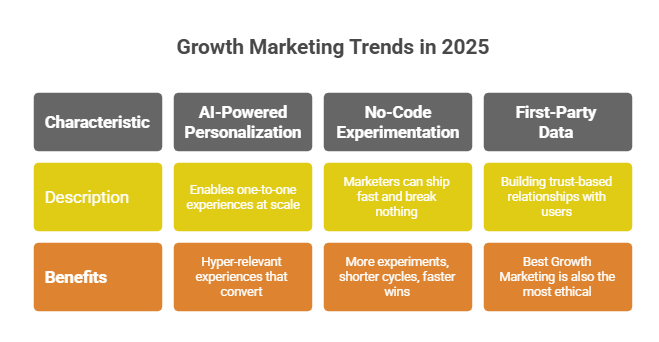
AI-Powered Personalization
AI is no longer science fiction—it’s your co-worker.
From personalized product recommendations to dynamic landing pages and chatbot flows, AI enables one-to-one experiences at scale.
Imagine a website that changes headlines based on your browsing history. That’s not magic—it’s machine learning in action.
Tools like Mutiny and Jasper are already helping Growth Marketers deliver hyper-relevant experiences that convert.
No-Code Experimentation
Technical bottlenecks? Say goodbye.
Thanks to no-code tools, Growth Marketers no longer need to beg developers for every A/B test or pop-up. With tools like Webflow, Unbounce, and Zapier, marketers can ship fast and break nothing.
This means more experiments, shorter cycles, and faster wins.
First-Party Data in a Cookieless Future
With third-party cookies going extinct faster than dinosaurs, first-party data is the new gold.
Growth Marketing in 2025 focuses on building trust-based relationships with users and collecting data directly via:
- Email opt-ins
- On-site behavior
- Loyalty programs
- Surveys & feedback forms
This shift favors brands who prioritize user value and transparent data practices—meaning the best Growth Marketing is also the most ethical.
Conclusion
Growth Marketing is not just a tactic—it’s a movement. It’s about adopting a mindset that prioritizes speed over perfection, data over opinions, and long-term gains over short-term vanity metrics.
As we step into a world of AI, privacy regulations, and ever-changing digital behavior, Growth Marketing remains your compass. It guides you through experimentation, optimization, and compounding wins.




